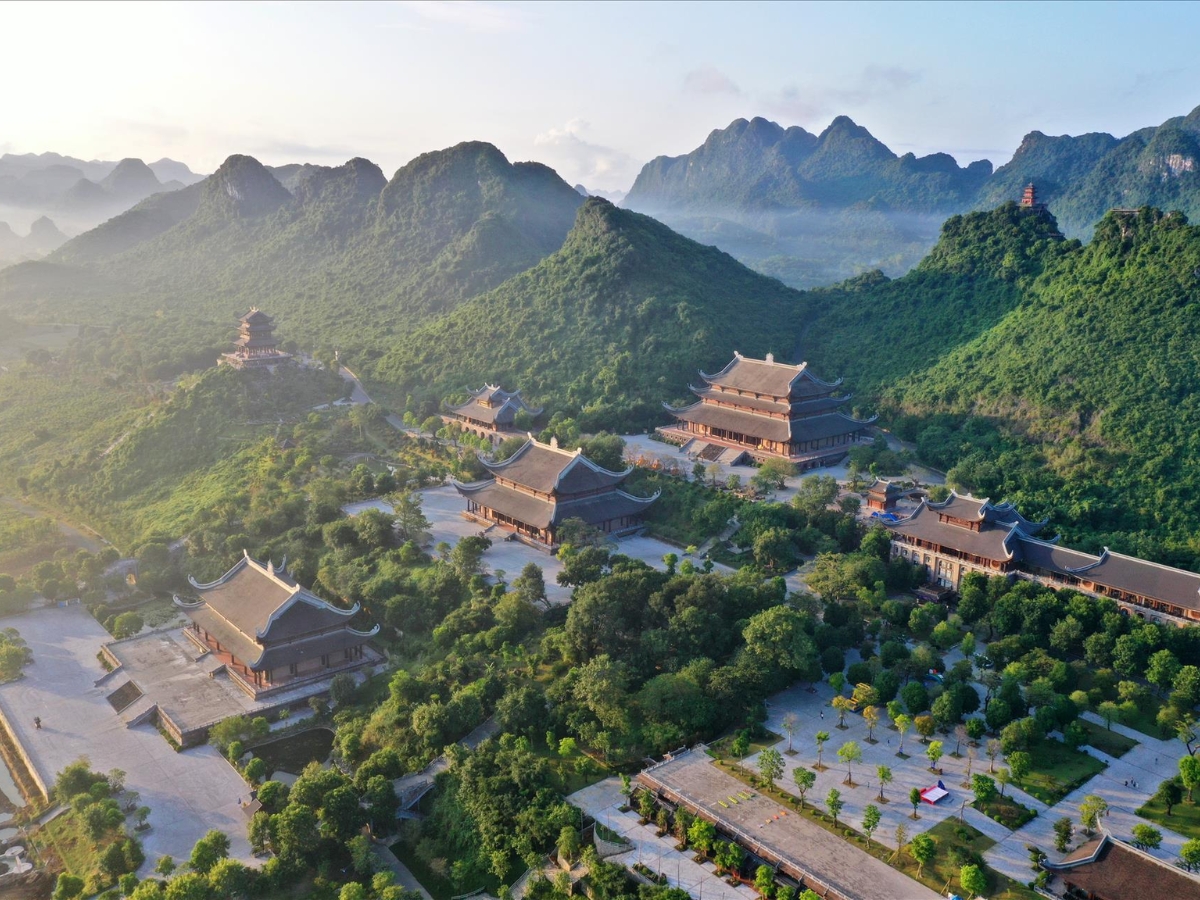1. Discover the beauty and historical value of Tam Diep Pass, Ninh Binh
1.1. Geographical location and outstanding features of Tam Diep Pass, Ninh Binh.
Located on the border between Ninh Binh and Thanh Hoa provinces, Tam Diep Pass, Ninh Binh is a complex of three consecutive passes on the Tam Diep mountain range, stretching over 20 km, and ranging from 2 to 7 km wide. This landmark serves as a natural dividing line between the North and Central regions of Vietnam, and is also the southern boundary of Ninh Binh province.
The name “Tam Diep” originates from the region's characteristic terrain, with three adjacent limestone mountains forming successive layers, undulating like majestic natural walls. According to historical records, the northern pass is about 75-80m high, the middle pass is the highest at 110m, and the southern pass is 80-90m high. The landscape of the Tam Diep region possesses the majestic beauty of typical limestone mountainous terrain, surrounded by lush green valleys stretching from the Hoa Binh range to near the East Sea coast. This place not only boasts fascinating natural beauty but also preserves profound historical and cultural values, closely linked to important milestones in the nation's process of building and defending the country.
1.2. Historical significance of Tam Diep Pass.
Tam Diep Pass, Ninh Binh was once a vital route connecting the North and South of the country through feudal dynasties, playing a crucial role in trade and military affairs. All armies of the past passed through this place, making the pass a strategic location on the historical map.

Tam Diep Pass Ninh Binh was once a vital route connecting the North and South of our country. (Source: Collected)
In 1788, this place became a defensive military base for the Tay Son rebels. When Ngo Thi Nham, Phan Van Lan, and Ninh Ton withdrew their troops from Thang Long to Tam Diep, this was the assembly point before King Quang Trung advanced to Thang Long citadel, defeating 200,000 Thanh troops in the Kỷ Dậu spring of 1789. That victory left a strong imprint of the indomitable spirit and intellect of the Vietnamese nation.
Throughout the dynasties, the pass's role has always been affirmed. During the Han period, the pass was named Cửu Chân Quan. Under the Later Lê dynasty, the pass served as the boundary between the inner and outer Thanh Hóa regions. In the Nguyễn era, it became the border between Ninh Bình and Thanh Hóa provinces at the pass. The Tam Diep defense system includes ramparts, forts, and temples such as Ba Dội Pass, Hầu Vua Hill, Dâu Temple, and Gióng Than Mountain, forming a solid shield protecting the southern part of Thang Long for centuries.
1.3. The Name and Cultural Imprint of Tam Diep Pass.
The name "Tam Điệp" appears in official historical records, while "Đèo Ba Dội" is the folk name, representing the image of three consecutive mountain ranges, accurately reflecting the unique topography of this land. That name has been deeply ingrained in the cultural memory of many generations of Vietnamese people.
Tam Diep Pass was once immortalized in poetry by the female poet Hồ Xuân Hương, symbolizing the hardships of travelers crossing the treacherous mountains and passes. These verses not only depict the majestic and wild beauty of the land but also express the strong, resilient spirit of the people on their journeys across the country.
For the local community, Tam Diep Pass Ninh Binh is not just a geographical location but also a symbol of cultural history. It was once an important gateway for trade and a crucial defense line for the Hoàng Long region, mentioned in folk songs and proverbs as a reminder of the challenges and the will to overcome difficulties of the Vietnamese people. These imprints have contributed to the spiritual value and unique cultural identity of the Tam Diep region.
2. Guide to Traveling to Tam Diep Pass Ninh Binh 2025
How to travel from Hanoi to Tam Diep Pass Ninh Binh:
Departing from Hanoi, tourists can choose to travel by car, bus, train, or motorbike to reach Tam Diep Pass Ninh Binh, covering a distance of about 110 to 120 km, with a travel time of 2 to 2.5 hours. The new National Highway 1A or the Hanoi - Ninh Binh expressway then branching off to the old National Highway 1 are two popular options to fully experience the pass.

Traveling by bus is both fast and economical. (Source: Collected)
Currently, the Tam Diep Pass tunnel has been put into operation, helping cars and large vehicles move safely and quickly all year round. However, if you want to fully enjoy the wild beauty of the mountains and feel the historical breath of this land, try taking the old mountain pass route by motorbike. The road winds around the mountainside, with forests, valleys, and solemn limestone blocks on both sides, bringing an emotional journey.
For a complete experience, visitors can combine both routes: take the tunnel to save time, then return via the old mountain pass to admire the scenery and take photos. This is an ideal way to explore modernity while immersing yourself in the natural and historical space characteristic of the Tam Diep Pass in Ninh Binh.
Journey from Ho Chi Minh City and Southern Provinces:
From Ho Chi Minh City or southern provinces, the options to travel to Tam Diep Pass Ninh Binh are quite flexible. Visitors can choose to fly to Hanoi or Thanh Hoa, then continue by bus, train, or private car. The distance from Noi Bai airport to the pass is 100 to 120 km, while from Tho Xuan airport (Thanh Hoa) it is only 65 km.
Those who enjoy sightseeing can take the North-South train line to Ninh Binh station, then take a taxi or local car to the pass. Additionally, sleeper buses to Tam Diep or Bim Son bus stations offer convenience and cost savings.
For those prioritizing convenience and time-saving, flying combined with a private car is a reasonable choice. Conversely, trains and buses are more suitable for those who want to enjoy the scenery along the way and consider their budget, even if the travel time is longer.
3. Memorable Experiences When Conquering Tam Diep Pass Ninh Binh
3.1. Exploring Historical Sites and National Imprints
Tam Diep Pass in Ninh Binh is not only famous for its majestic scenery but also a land steeped in historical imprints associated with the glorious pages of the nation. One of the special stops is the "Qua Tam Diep Son" stele house, located on the middle peak of the pass. This ancient stele bears a poem by King Thieu Tri, written in 1842 during his tour of the Tam Diep mountain region. The poem not only showcases the king's literary talent but also affirms Tam Diep's important strategic position.
Heading south, visitors will encounter the Tam Diep Citadel, a military structure built by the Tay Son dynasty in the late 18th century to strengthen the defense line protecting Thang Long Imperial Citadel. The citadel is nearly square, with each side about 65-70 meters long, and traces of deep moats still surround its four sides. Beneath the moss, the ancient stone walls seem to retain the echoes of a time of war. Today, this relic has been recognized as a National Historical Site, becoming an attractive destination for history enthusiasts.
Notably, this place is also associated with the brilliant victory of King Quang Trung in 1789, when he chose Tam Diep as a military base before advancing to liberate Thang Long. Under the command of Ngo Thi Nham, the Tam Diep defense line became a symbol of the nation's intelligence, courage, and indomitable spirit. Visiting Tam Diep today, visitors can not only admire the mountainous scenery but also clearly feel the heroic atmosphere of history, where every brick and every inch of land is imbued with pride in Vietnam's glorious past.
3.2. Natural Landscape, Trekking Mountains to See the "Border" Between North and Central Vietnam.
The majestic limestone mountains of Tam Diep Pass Ninh Binh form a grand wall, covered in lush green all year round, like a natural shield protecting the southern citadel. The mountains follow each other, with varying heights, creating a magnificent landscape, especially in the early morning when a light mist hovers around the cliffs.

Majestic natural landscape at Tam Diep Pass. (Source: Collected)
For those who love exploration, a trekking journey along the middle of the pass is a memorable experience. This was once considered the historical "boundary" between the North and Central regions. From the top of the pass, visitors can gaze out at the vast green rice fields of Ninh Binh to the north and the immense Thanh Hoa region to the south.
Today, traces of the ancient imperial road are still visible through overgrown trails. The quiet and ancient atmosphere here makes visitors feel as if they are returning to the past – a place that once echoed with the footsteps of ancient people and witnessed many heroic stories in the nation's history.
3.3. Modern Intersection: Expressway, Mountain Tunnel, and New Scenery
The appearance of the North-South expressway and the tunnel through Tam Diep Pass Ninh Binh has brought a new breath to the land that once bore the marks of many historical victories. The modern road cuts through the dense limestone mountains, opening up an easy and safe travel route in all weather conditions.
On both sides of the road, the natural scenery retains its original pristine beauty. Towering limestone mountains covered in green forests, sometimes hidden in the early mist, sometimes shining brightly in the afternoon sun, create a harmonious picture between stillness and movement. Along the expressway, patches of forest, small valleys, and winding streams still exist alongside modern structures, allowing visitors to feel the pulse of the era while finding peace amidst the majestic nature.
4. Cuisine and Specialties around Tam Diep Pass Ninh Binh
A journey to Tam Diep Pass Ninh Binh is not only an exploration of nature and history but also an opportunity for visitors to enjoy flavors of cuisine that deeply reflect the mountainous region. Amidst the misty fog and fresh air, the simple, rustic dishes here seem to have their flavors enhanced, leaving a lingering, unforgettable impression.
Grilled or steamed wild boar (lon man) is the most characteristic dish that anyone should try at least once. The firm, naturally sweet wild boar meat is simply marinated to preserve its original mountain flavor. When grilled over charcoal, the crispy golden skin and the tender, sweet, and fragrant meat inside make everyone who tastes it exclaim with delight.

Enjoy grilled wild boar specialty. (Source: Collected)
Yen Mac Nem, a famous traditional dish of Ninh Binh, is appealing in a different way. Each piece of naturally fermented nem, wrapped in fig leaves with a little garlic, creates a mild sourness, a slight spiciness, and a characteristic aroma. Eating a piece of nem, sipping it with a local glass of wine, you will clearly feel the rustic, hospitable spirit of the people of this land.
Especially, the meal at Tam Diep Pass Ninh Binh becomes more complete with "dua truong" (pickled vegetables), processed from a special wild vegetable of the highlands. The vegetables are lightly pickled, eaten with meat dishes to balance the richness, creating a special harmony. And of course, the crispy, golden Ninh Binh burnt rice cannot be missed, dipped in rich goat sauce, creating an unforgettable flavor.
On the journey through the pass, tourists can stop at local eateries located along National Highway 1A or in the center of Tam Diep city. Tam Diep restaurant is a favorite choice for many tourists with its spacious atmosphere, majestic mountain views, and a rich menu including wild boar, nem, and burnt rice.
Eateries around Tam Diep Pass Ninh Binh often have open spaces, fully utilizing the beauty of the majestic mountains. Amidst the smoky aroma of grilled dishes, visitors can enjoy local specialties while admiring the lush green mountains and forests. This is a simple yet poetic experience, leaving an unforgettable aftertaste after each trip.
5. Festivals and Folk Culture Associated with Tam Diep Pass Ninh Binh
5.1. Traditional Festivals of the Tam Diep – Bim Son Region.
The Dau Temple Festival (Ninh Binh) takes place from the 15th day of the first lunar month to the 3rd day of the third lunar month, commemorating the merits of the Tay Son generals. The festival is held with rituals such as offering sacrifices to Quang Trung, palanquin processions, and many unique folk games. The festival atmosphere is both solemn and lively, expressing the people's gratitude to the historical heroes.
The Song Temple Festival (Thanh Hoa) is held annually with rituals such as worshipping heaven and earth, praying for peace, lion dances, water processions, and many traditional ceremonies, attracting a large number of visitors. This event contributes to the unique cultural imprint of the Tam Diep Pass Ninh Binh region.

Festival of Song Temple in Thanh Hoa. (Source: Collected)
The festivals here not only hold spiritual significance but also serve as an occasion for the communities of Ninh Binh and Thanh Hoa provinces to meet and interact. The rituals, preserved from generation to generation, reflect respect for ancestors and love for the homeland and country.
5.2. Community Activities, Cultural Imprints of Two Regions.
At Tam Diep Pass Ninh Binh, folk performances, the sound of festival drums, or lively dragon and lion dances during festivals are not just recreational activities but also carry the breath of cultural exchange. This is the natural boundary between the North and the Center, so the rituals, dances, and songs clearly reflect the spirit of blending between the two regions, both familiar and unique.
The cuisine, beliefs, and local language in this area also bear strong imprints of this exchange. During meals, you might find dishes with the rich flavor of Central Vietnamese shrimp paste alongside a bowl of Northern-style garden vegetable soup, or hear locals alternating between the accents of both regions. This natural blend has formed a unique identity for the people of Tam Diep, where every cultural aspect is a vivid testament to harmony.
Community activities around the pass always aim for solidarity, openness, and connection. Whether it's a village festival, a spring market, or traditional cultural days, people from both regions gather, sing, and share joy. This atmosphere creates a unique cultural hue, where past and present merge in the historic land of Tam Diep Pass Ninh Binh.
6. Tips and Notes for Exploring Tam Diep Pass Ninh Binh
Attire, Gear, and Safety for Trekking and Motorbiking the Ancient Pass:
When embarking on a journey to conquer Tam Diep Pass Ninh Binh, visitors should choose light, breathable clothing that still ensures safety. Sports shoes or trekking boots are ideal for stable movement on the rugged limestone terrain. A light jacket, a wide-brimmed hat, or a cap will help protect the body from the unpredictable mountain sun and wind.
For personal items, bring a water bottle, a light raincoat, a power bank, insect repellent, and especially an offline map, as some sections may have lost phone signal. Traveling in groups and informing relatives of your itinerary are essential for safety. Avoid traveling during the rainy season, especially when the pass road is slippery, and refrain from splitting up when moving on small trails. Thorough preparation will not only make the trip more complete but also provide a memorable trekking experience amidst the Tam Diep mountains.
Civilized Behavior, Protecting Relics and Landscapes:
During the exploration of Tam Diep Pass Ninh Binh, visitors should pay attention to maintaining cleanliness, not littering, and minimizing impact on ancient relics such as stone steles or old ramparts. Every small action contributes to preserving the historical value and natural beauty of this land. When visiting temples, pagodas, or attending festivals, dress respectfully, maintain a solemn attitude, and avoid making noise. This is not only a matter of politeness but also a way to show respect for the local culture.
The sense of conservation is also reflected in not breaking branches, picking flowers, or carving on mountain rocks. Each tourist is a guardian and promoter of the sustainable beauty of Tam Diep Pass Ninh Binh, so that this place remains the pride of the North-Central transitional region.
Suggestions for Combining Tourism with Nearby Attractions:
After exploring Tam Diep Pass Ninh Binh, visitors can combine visits to famous attractions in the area. To the east lies the Trang An complex, Mua Cave, and Tam Coc, which are described as "Ha Long Bay on land," nổi bật with limestone mountains, winding rivers, and peaceful scenery.
To continue the journey, visitors can visit Sun World Ha Nam and Tam Chuc Pagoda for sightseeing, worship, and to enjoy the modern water park. Combining visits between Tam Diep Pass Ninh Binh and nearby destinations not only enriches the trip but also provides a complete experience, connecting the majestic nature with the unique spiritual culture of Northern Vietnam.

Combine sightseeing and worship at Tam Chuc Pagoda. (Source: Collected)
The journey to explore Tam Diep Pass Ninh Binh not only brings moments of relaxation amidst majestic nature but also helps visitors deeply feel the historical breath of the land where the North and Central regions intersect. If you are looking for a place to temporarily put aside the noisy rhythm of life, breathe in the fresh air, and immerse yourself in the wild beauty, Tam Diep Pass Ninh Binh is the ideal destination. Plan your trip today to personally experience the harmonious beauty between nature, history, and people in this legendary land.





